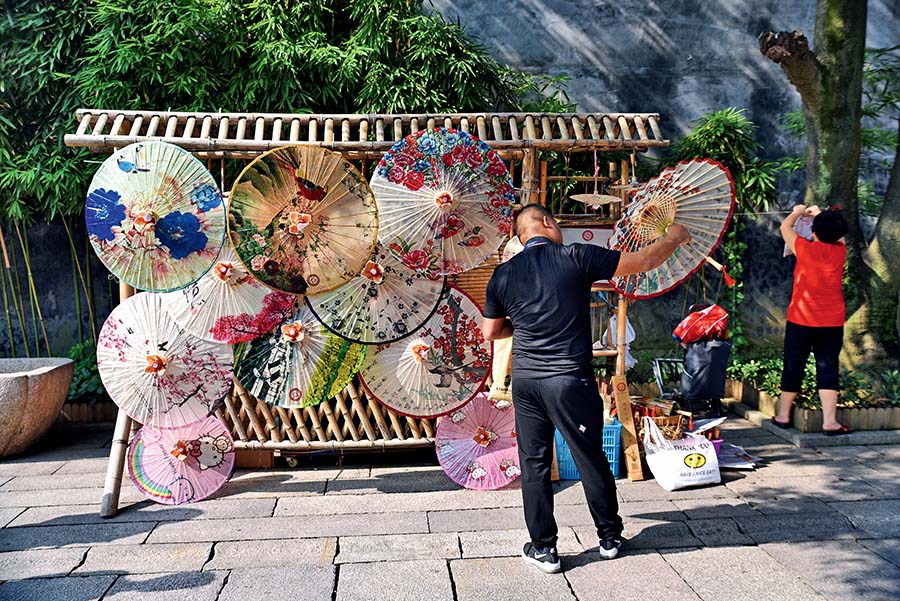Fuzhou to Quanzhou

Last October, I was lucky enough to be invited to participate in the 2nd Maritime Silk Road International Tourism Festival in Fujian Province, which was meant to promote Fujian Province and help it become more popular among Chinese and foreign tourists. This event took me from Fuzhou to Quanzhou and gave me a new glimpse of southern China, which I had discovered a year and a half ago when I traveled to Guangdong Province. Fujian is most famous for “tulou”, round buildings typical of the Hakka ethnic minority. But the coastal and mountainous areas of Fujian Province have much more to offer.
The first thing that struck me about Fujian mirrored my feelings upon arrival in Guangdong and Guizhou provinces: Southern Chinese culture starkly contrasts that of the North. As we shuttled through different cities, we caught sight of beautiful typical southern Chinese architecture and temples from the highway as well as countless crop fields with amazing vegetation thanks to the tropical climate of southern China.

Upon arrival in Fuzhou, the capital of Fujian Province, which is known as the City of Banyans for its beautiful trees, our first destination was the charming “Three Lanes and Seven Alleys”, or “Sanfang Qixiang” in Chinese. The traditional architectural complex is composed of small traditional alleys similar to the hutongs of Beijing. Often referred to as a “museum of ancient architecture of the Ming and Qing dynasties,” construction started in the Jin Dynasty (265-420), took shape in the late Tang Dynasty (618-907) and culminated in the Ming and Qing dynasties (1368-1911). The area has also been inhabited by very influential figures in Chinese history and remains iconic of Fuzhou’s long history and strong culture. The ancient buildings have been well preserved and restored, and many small restaurants and shops where tourists and locals enjoy the flavors of Fuzhou now flank them. Just discovering the place was a joyful experience in and of itself. Although the main lanes are crowded and quite comercial, small peripheral alleys invite visitors to stroll these narrow peaceful streets and their many residential buildings. Some are now museums welcoming visitors.

An attractive Fuzhou characteristic that has nothing to do with culture is its hot springs. At the same time as the Maritime Silk Road tourism festival was held in 2016, the 7th Fuzhou Hot Spring International Tourism Festival was also held. While attending this festival we found the opportunity to take a dip in the warm waters of Xishan Hot Spring Resort, which proved a wonderful experience. The resort features over 50 different outdoor pools at various temperatures. The water is heated by volcanic activity under Fujian Province. Some pools overlook a river below, making the experience really magical.
The next day we took the bus to Songkou Ancient Town in Yongtai County of Fuzhou for the 1st Folk Custom Tourism Cultural Festival. The ancient town has a history of over 1,000 years, and just like the Three Lanes and Seven Alleys, it is notable for a wealth of well-preserved old buildings from the Ming and Qing dynasties. Al Although several cultural activities organized as part of the festival led my group deeper into the traditional folk culture of Songkou and Fuzhou, the city isn’t yet a year-round major tourist destination, which keeps it tranquil. It was especially pleasant to witness the lives of the local people, some of whom were probably witnessing foreign faces for the first time.

The ancient town of Songkou is along the way to Quanzhou, our next destination and a former important port city on the Maritime Silk Road. The biggest tourist draw of Quanzhou is the Kaiyuan Temple, an ancient structure built in 686 during the Tang Dynasty and the largest Buddhist temple of Fujian Province. Interestingly, it houses fragments of a Hindu temple built in Quanzhou in the 13th century by the Tamil community. But perhaps the most impressive structure in the town is the beautiful Reshou Pagoda in the garden of the temple complex. It includes several courtyards.

My favorite stop on the trip was the Hui’an women’s community in Chongwu ancient fishing village. The village is particularly notable because they used seashells to construct many of its walls, but its other peculiarity is a community of Hui’an women who maintain a traditional shellfish farm. Hui’an women are a community of Han women with roots in Hui’an County, Quanzhou, known for their hard work and unique customs. They wear colorful traditional costumes and welcomed us with traditional dances. However, modern times have been overpowering tradition, and the community’s average age is quite high. Many of the women we met were over 80 years old. I felt tremendously honored for the chance to visit the amazing women of the community and their beautiful village.
Too soon I had to leave sunny Fujian and return to cold Beijing. I really wished I could have extended my trip with the final touch of the province’s beautiful beaches.